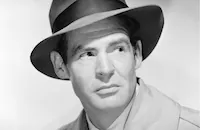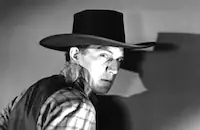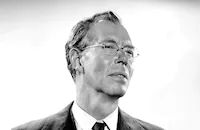Return of the Bad Men

Brief Synopsis
Cast & Crew
Ray Enright
Randolph Scott
Robert Ryan
Anne Jeffreys
George "gabby" Hayes
Jacqueline White
Film Details
Technical Specs

Synopsis
In 1889, in the territory of Oklahoma, the government-owned town of Braxton is closing down in preparation for the upcoming land rush. The government's offer of free land is attracting not only settlers, but outlaws as well. One group of outlaws, which includes the Sundance Kid, Wild Bill Yeager, George Mason, Billy the Kid, the Younger brothers and the Arkansas Kid, forms under the leadership of Wild Bill Doolin, a veteran bandit whose tough-talking niece Cheyenne also rides with the gang. Doolin plans to rob the Braxton bank and use the stolen cash to finance a series of heists following the land rush. The bank is owned by John Pettit, whose widowed daughter, Madge Allen, works for him as a clerk. Although federal authorities attempt to warn John of the gang's activities, Cheyenne intercepts their telegram before he can be notified. Later, Cheyenne delivers the hold-up message to Madge as John unwittingly entertains the gang, who are posing as ranchers, in his office. The outlaws are spotted in the act by Johnny, Madge's young son, who then alerts the town to the robbery. As the townsmen descend on the bank, the outlaws flee, and during their escape, Cheyenne is shot in the arm. Cheyenne is taken in by the unsuspecting Vance Cordell, Madge's fiancé and a former Texas Ranger, who nurses the outlaw at his recently sold ranch. Vance soon realizes Cheyenne's true intentions, however, and tries to convince her to reconsider her criminal ways. When Cheyenne refuses to turn herself in, Vance is forced to lead her at gunpoint to town. As Sundance, Billy the Kid and Cole Younger search Vance's ranch for Cheyenne, Sundance kills Grey Eagle, an old, devoted hand, for refusing to reveal her whereabouts. The outlaws then ambush Vance and free Cheyenne. Later, while riding behind Sundance, Cheyenne remembers Vance's admonitions and decides to return to town with the money. After disarming Cole and Sundance, who threatens retribution, she rejoins Vance and turns herself in to Judge Harper. Vance then bids farewell to Madge, who is going to Kansas City in anticipation of their marrying and moving to California. Soon after her departure, the last remaining citizens of Braxton take off, and the land rush begins. Out of the chaos, the town of Guthrie is founded near the ghost-like Braxton, and John opens its first bank. Fearing trouble from the Doolin gang, army colonel Markham appoints Vance to be the temporary marshal once his troops leave town. Vance at first refuses the post, but when he hears that Sundance has just robbed a stagecoach, he tells Madge, who has come to Guthrie to retrieve her fiancé, that he must help to bring the Doolin gang to justice. Madge, whose first husband was a sheriff who died in the line of duty, reluctantly accepts Vance's decision, but confides to her father her fears about marrying another lawman. Later, while the Dalton brothers join Doolin's gang, Judge Harper paroles a fully rehabilitated Cheyenne to Vance's custody. Vance allows Cheyenne, who now goes by her real name, Jeanie McBride, to oversee his telegraph office and, unaware that she is love with him, entrusts her to Madge's care. Soon, the Doolin gang begins its unrelenting crime spree, and Vance begins deputizing townsmen in an effort to stop it. A jealous Madge, meanwhile, confronts Cheyenne about her interest in Vance, and Cheyenne advises her rival to marry Vance immediately. When Madge proposes a quick marriage to Vance, however, he gently rebuffs her while reassuring her of his love. Vance then deduces that the outlaws are hiding out in Braxton and brings his deputies together to pursue them. After Vance's posse corners the outlaws in the Braxton saloon, Doolin is captured, but Sundance and several others escape. To prove his loyalty to the gang, Sundance offers to break Doolin out of jail and tries to force Cheyenne to reveal the time that her uncle is to be transported. When Cheyenne refuses to tell, Sundance strangles her in the marshal's office, but is once again spotted by a passing Johnny, who brings the posse. While fleeing town, the Arkansas Kid's horse goes lame, but instead of helping, Sundance shoots the Kid. Fed up with Sundance's viciousness, Wild Bill Yeager separates from him and is soon killed by Vance. The lone outlaw returns to Braxton, and there he and Vance have a final gunfight, which Vance wins. Later, the now married Madge and Vance inform John that they are remaining in Guthrie, and are surprised when John announces that he is fed up with banking and is moving to California.

Director
Ray Enright
Cast

Randolph Scott

Robert Ryan

Anne Jeffreys

George "gabby" Hayes

Jacqueline White

Steve Brodie
Richard Powers
Robert Bray

Lex Barker

Walter Reed
Michael Harvey
Dean White

Robert Armstrong

Tom Tyler
Lew Harvey

Gary Gray

Walter Baldwin

Minna Gombell
Warren Jackson
Robert Clarke
Harry Shannon
Charles Mcavoy
Larry Mcgrath
Wayne Mccoy
Billy Vincent
Howard Mccrorey
Ernie Adams
Sam Flint
George Nokes
Ronnie Ralph
Polly Bailey
Forrest Taylor
Bud Osborne
Brandon Beach
Frank O'connor
Lane Chandler
Earle Hodgins
Charles Stevens

Kenneth Mcdonald

John Hamilton
Richard Thorne
Cy King
Dan Foster
Ida Moore
Crew
James Altwies
C. Bakaleinikoff
Gordon Bau
Samuel E. Beetley
Ralph Berger
Russell A. Cully
Albert S. D'agostino
Mort Greene
Jack J. Gross
Nat Holt
J. Roy Hunt
Terry Kellum
Jack Natteford
Jack Natteford
Charles O'neal
Harold Palmer
Renie
Harry Revel
Grayson Rogers
Paul Sawtell
Darrell Silvera
Jean L. Speak
Luci Ward
Luci Ward

Photo Collections
Film Details
Technical Specs

Articles
Return of the Badmen
Scott got very dirty battling a bevy of Western villains in Return of the Badmen. The success of 1947's Badman's Territory prompted RKO Radio to produce a sequel of sorts, with Scott returning as the lead hero. The RKO production was more than just a sequel though. Return of the Badmen was symptomatic of a popular story contrivance in Hollywood picture making in the forties, one that crossed genre lines. The idea of a "super Western," with a hero facing off against an inordinate number of villains in a single movie, actually took root in the horror picture. When horror film producers began to lose the audience's attention, their first move was to offer two monsters for the price of one, as in Frankenstein Meets the Wolf Man (1943), then later three or four monsters in House of Frankenstein (1944). Western filmmakers followed this same logic by throwing figures like Jesse James, Belle Starr, the Dalton Gang and others into an organized crime wave that sweeps the Old West, until a lawman like Randolph Scott can stop it. Rather than relying on a simple plot contrivance, Return of the Badmen goes one step further and creates real tension between Randolph Scott's marshal and Robert Ryan's Sundance Kid.
Return of the Badmen posted a huge profit, spawning another "all-star villain" western from RKO in 1951 called Best of the Badmen, this time starring Robert Ryan as a former Union soldier exacting revenge on Robert Preston with help from the James and Younger gangs.
Director: Ray Enright
Producer: Jack J. Gross, Nat Holt
Screenplay: Charles O'Neal, Jack Natteford (story), Luci Ward (story)
Cinematography: J. Roy Hunt
Music: Mort Greene, Harry Revel, Paul Sawtell
Art Direction: Ralph Berger, Albert S. D'Agostino
Cast: Randolph Scott (Vance), Robert Ryan (Sundance Kid), Anne Jeffreys (Cheyenne), George ÔGabbyÕ Hayes (John Pettit), Jacqueline White (Madge Allen), Steve Brodie (Cole Younger), Tom Keene (Jim Younger), Robert Bray (John Younger).
BW-91m. Closed Captioning.
by Scott McGee

Return of the Badmen
Quotes
Trivia
Notes
Return of the Bad Men was conceived as a companion film to the successful 1946 RKO film Badman's Territory . Although some of the same real-life outlaw characters appear in both films, and Randolph Scott stars in both pictures, there is little similarity between the two films. The 1951 RKO film Best of the Badmen, which was directed by William D. Russell and starred Robert Ryan and Claire Trevor, featured the Younger Brothers and other real-life outlaws, but was not a sequel to either this film or Badman's Territory. The depiction of these outlaws was highly fictionalized in Return of the Bad Men. For more information on Billy the Kid, for Billy the Kid. For more information on the Younger Brothers, for Bad Men of Missouri. For more information on other outlaws portrayed in the story, consult the Subject Index. Some scenes for this film were shot near Bakersfield, Saugus and Fillmore in southern California. During filming at RKO's Encino ranch, a fire broke out and damaged the Western street set, according to Hollywood Reporter.
















